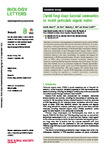Chytrid fungi shape bacterial communities on model particulate organic matter
| dc.contributor.author | Roberts, C | |
| dc.contributor.author | Allen, R | |
| dc.contributor.author | Bird, KE | |
| dc.contributor.author | Cunliffe, Michael | |
| dc.date.accessioned | 2021-09-20T11:30:50Z | |
| dc.date.available | 2021-09-20T11:30:50Z | |
| dc.date.issued | 2020-09 | |
| dc.identifier.issn | 1744-9561 | |
| dc.identifier.issn | 1744-957X | |
| dc.identifier.other | 20200368 | |
| dc.identifier.uri | http://hdl.handle.net/10026.1/17851 | |
| dc.description.abstract |
<jats:p> Microbial colonization and degradation of particulate organic matter (POM) are important processes that influence the structure and function of aquatic ecosystems. Although POM is readily used by aquatic fungi and bacteria, there is a limited understanding of POM-associated interactions between these taxa, particularly for early-diverging fungal lineages. Using a model ecological system with the chitin-degrading freshwater chytrid fungus <jats:italic>Rhizoclosmatium globosum</jats:italic> and chitin microbeads, we assessed the impacts of chytrid fungi on POM-associated bacteria. We show that the presence of chytrids on POM alters concomitant bacterial community diversity and structure, including differing responses between chytrid life stages. We propose that chytrids can act as ecosystem facilitators through saprotrophic feeding by producing ‘public goods’ from POM degradation that modify bacterial POM communities. This study suggests that chytrid fungi have complex ecological roles in aquatic POM degradation not previously considered, including the regulation of bacterial colonization, community succession and subsequent biogeochemical potential. </jats:p> | |
| dc.format.extent | 20200368-20200368 | |
| dc.format.medium | Print-Electronic | |
| dc.language | en | |
| dc.language.iso | en | |
| dc.publisher | Royal Society, The | |
| dc.subject | bacteria | |
| dc.subject | fungi | |
| dc.subject | particulate organic matter | |
| dc.title | Chytrid fungi shape bacterial communities on model particulate organic matter | |
| dc.type | journal-article | |
| dc.type | Journal Article | |
| dc.type | Research Support, Non-U.S. Gov't | |
| plymouth.author-url | https://www.webofscience.com/api/gateway?GWVersion=2&SrcApp=PARTNER_APP&SrcAuth=LinksAMR&KeyUT=WOS:000576643900001&DestLinkType=FullRecord&DestApp=ALL_WOS&UsrCustomerID=11bb513d99f797142bcfeffcc58ea008 | |
| plymouth.issue | 9 | |
| plymouth.volume | 16 | |
| plymouth.publication-status | Published | |
| plymouth.journal | Biology Letters | |
| dc.identifier.doi | 10.1098/rsbl.2020.0368 | |
| plymouth.organisational-group | /Plymouth | |
| plymouth.organisational-group | /Plymouth/Faculty of Science and Engineering | |
| plymouth.organisational-group | /Plymouth/Faculty of Science and Engineering/School of Biological and Marine Sciences | |
| plymouth.organisational-group | /Plymouth/REF 2021 Researchers by UoA | |
| plymouth.organisational-group | /Plymouth/REF 2021 Researchers by UoA/UoA07 Earth Systems and Environmental Sciences | |
| plymouth.organisational-group | /Plymouth/Users by role | |
| plymouth.organisational-group | /Plymouth/Users by role/Academics | |
| dc.publisher.place | England | |
| dcterms.dateAccepted | 2020-09-08 | |
| dc.rights.embargodate | 2021-9-21 | |
| dc.identifier.eissn | 1744-957X | |
| dc.rights.embargoperiod | Not known | |
| rioxxterms.versionofrecord | 10.1098/rsbl.2020.0368 | |
| rioxxterms.licenseref.uri | http://www.rioxx.net/licenses/all-rights-reserved | |
| rioxxterms.licenseref.startdate | 2020-09 | |
| rioxxterms.type | Journal Article/Review |


